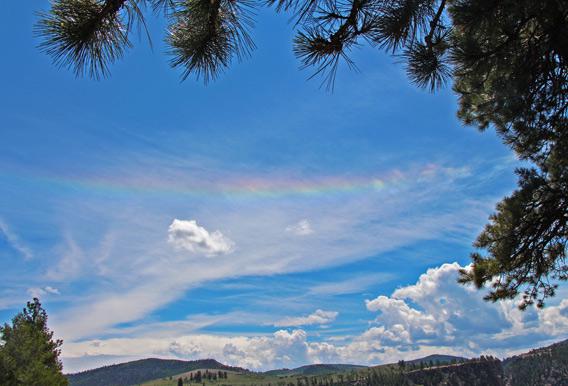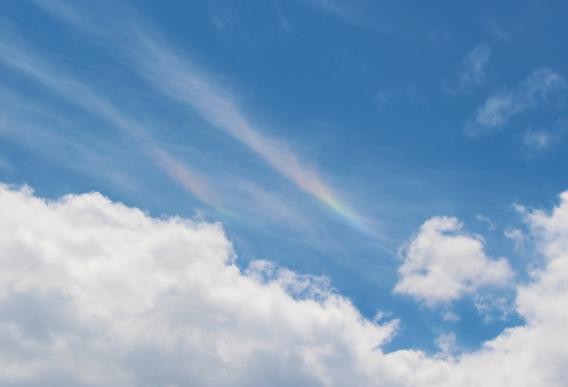(After the unpleasantness of this morning’s earlier post, consider this a Unicorn Chaser.)

Photo by Phil Plait
Over the weekend, my family and I went on a little trip west, to Gunnison, Colo. We wanted to poke around the area a bit for a possible future Science Getaway, a series of science vacations my wife and I organize. We loved the town and the location—the area is gorgeous, with jaw-dropping geological formations and great outdoor activities, so stay tuned for news about this.
We took a trip out to Black Canyon, an ancient and incredibly steep-walled gorge cut by the Gunnison River. I could write a thousand words on that ravine alone; on the north side the rock dates back to the Mesozoic Era, but the dark rock on the south side is pre-Cambrian, 1.7 billion years old! I didn’t even know rocks that old were still extant in the United States. Amazing.
But as phenomenal as the canyon was, I got a big surprise when I looked up, not down. As I was driving to a spot where we could eat lunch, I glanced out my car window and saw a bright flash of color in the sky. I thought at first it was a sundog: a rainbow-patterned teardrop shape in the sky caused by ice crystals in the clouds breaking up sunlight into its component colors. But then I saw the colors extended well off to the side, and I suddenly realized what I was seeing: a circumhorizon arc (sometimes erroneously called a fire cloud, and no, they can’t foretell earthquakes).
Circumhorizon means “circling the horizon,” due to the shape of the arc, which is parallel to the horizon line. These arcs are relatively rare compared to other optical phenomena, and in all my years looking at the sky I had never seen one so complete before. Needless to say, I stopped the car, leapt out, and took a bunch of photos. The arc persisted for nearly an hour, and I was able to get some good shots from different spots. The picture at the top of this post was the best; the clouds were perfectly placed such that the arc spanned a solid 40 degrees of sky. The colors were obvious, and brightest where the clouds were thickest (I fiddled with the saturation and the contrast of the pictures here to bring out the arc, but it really looked like this in the sky).

Photo by Phil Plait
As the clouds moved, the patterns in the arc changed. At one point, just a pair of high cirrus clouds showed colors:
A circumhorizon arc (or sometimes circumhorizontal arc) is different from a rainbow, which forms when water droplets in the air reflect and refract (bend) back to you. For a circumhorizon arc to form, you need flat ice crystals that are like hexagonal plates. As they fall, they tend to orient themselves horizontally, flat-side toward the ground. Light enters one of the six, short vertical sides; bends (in the same way a prism bends light—click that link for a great diagram of this); then leaves the crystal through the flat side facing the ground. This breaks the white sunlight into its colors, which are oriented parallel to the horizon (unlike a rainbow, which is curved). Also, due to the geometry, the Sun has to be higher than 58 degrees above the ground for this to work.

Photo by Phil Plait
That means these can only be seen in the summer, when the Sun gets that high. You also need a clear view of the horizon and the right kind of ice crystals to bend the light. I was surprised to find that circumhorizon arcs are not all that rare—you can expect a few every summer—yet I had never seen one before. I suspect that’s because I rarely have a good, clear horizon. At the canyon, we were fortunate enough to get a perfect confluence of all three ingredients.
I’ll note there was also a faint but nice 22-degree halo around the Sun for a while, too, which is also caused by ice crystals. Haloes are pretty common; I usually see a couple dozen or more a year. The Sun doesn’t need to be high, so they can form in the winter, and in fact the ice crystals needed to make them are common in the winter. Most people have never seen one, which is too bad; they’re very pretty and sometimes can be incredibly bright. That’s stunning when you catch one.
Most astronomers I know reflexively look at the sky when they’re outside, day or night. It’s a good habit; you never know what you might see. A meteor, a bright planet, or an aurora after sunset, or an interesting cloud, the Moon, or a pretty display of atmospheric optical phenomena during the day.
In this case, I’m very glad I formed this habit years ago. It really paid off this time, and my family and I got a glimpse of some of the amazing—and surprising—diversity and beauty of nature.
(Weird coincidence: Just after drafting up this article, I was reading my news feeds and saw an article about circumhorizon arcs on the Earth Science Picture of the Day!)